1.
Traveling in India, like so much of this country, is able to simultaneously embody both the best and worst of the world.
For example, India is one of the last places on Earth where flying is truly enjoyable. The (private) airlines here are ruthlessly efficient with almost obsequiously polite staff. New world-class airports are going up faster than they can be filled with passengers. The security is a little heavy handed, but this is a country where terrorism is all too common and, thankfully, the zealotry of the security staff is currently greater than that of the terrorists.
If you fly during the tail end of the monsoon season - as we did - you can catch some stunning sunset views:

The only problem with the whole system is that it is hub-and-spoke and there are only a few hubs. There are a lot of places that you simply cannot easily fly to.
And that leaves you can with the bus or the railway.
We haven't taken the train yet as the convoluted system of booking (you reserve, you then get a ticket, then you find it's overbooked, then the trains cancelled, then...) has been off-putting and we've been traveling to places better served by bus.
However, the bus, for the most part, is a complete zoo. You head to a station or an unmarked stop on the road and ask every single bus that comes by if it's going to your destination. Occasionally, a friendly Indian will tell you which bus to get on (a few kind souls have saved us more than once) and then you're off. The bus may or may not have a door; for the locals it will only come to a rolling stop and no matter how long the journey, they'll keep filling it up as long as there's space to fit one more person:

It's cheap, but very slow. With all the stops, plus the fact that the bus is twenty-going-on-fifty years old, you're going to top out at 40km/h.
There's another option available that straddles both: a private driver. For two people this is a nice way to travel to out of the way places at a somewhat reasonable cost. What would be two days via two or more buses or impossible by flight can be condensed down into about nine hours in a cramped Tata Indigo (the seats have not been optimized for North American stature).
Even with your private driver, you shouldn't expect to go too fast. In fact, there's likely to be an order of magnitude difference in speeds during your journey. Some of the tracks (I can't call them 'roads' as that would be unfair to real roads) you'll follow in various towns will be so badly paved that you'll top out at just under 10km/h. And these are the major routes: you'll be sharing the track with any number of trucks (or, as they are quaintly called here, lorries).
The most random reason we lost speed was because young entrepreneurs in one village had strewn logs across the road and started collecting their own tolls.
Also, heaven forfend that you need to stop at a railway crossing to wait for a train. This country is massively overpopulated and everyone has to fight for temselves; personal space in non-existent. That's why you see everyone clustered on the bus above. It's why people play crappy Hindi pop from their cellphone speaker while taking the bus; headphones be damned. It's why a mob forms to board said bus. It's why everyone elbows you in the free-for-all that is a ticket counter anywhere (the British habit of queuing did not survive Independence). And it's why traffic fills up each lane at a railway crossing.
This has the obvious consequence that when the guard railing rises, you're left with three rows of traffic each facing each other separated by about eight feet. Both sides move forward, testing who will blink first. Nobody moves for a good 10 minutes while honking, screaming and hand-waving erupts. Somehow cars contort themselves in different directions and traffic begins to flow again after a wait that could easily have been avoided had everyone simply stayed in their respective lanes.
Sometimes India makes the simple very complex.
Between towns a fairly robust network of divided four lane highways is sprouting (there's an impressive network of private highways). They're relatively car-free right now (at one point I timed 3:45 between two cars; on average, a car came by about every 1:00-1:20), but are swamped with all sorts of trucks.
Some of these trucks are almost too big to even consider driving:

Others are simply ridiculously overloaded:

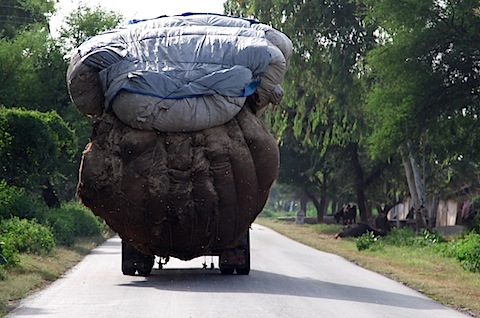

Our driver assured us that many of these overloaded lorries "weren't heavy"; I'm sure that will be consoling to some poor bastard who finds his legs sticking out from underneath them after it takes a corner too fast. You'll see frequent accidents. (These trucks are also an environmental mess, spewing nasty diesel fumes; your snot will turn black)
Curiously, in an unforeseen outcome of globalization, some of the tarps on these trucks are old cloth billboards from America. So far I've seen a Verizon ad plus another for the classified section of the Atlanta Journal-Constitution.
Overloaded trucks driven by new-to-driving drivers aren't the only issues to contend with on highways. Social norms are a little different here, so you frequently see people driving the wrong way down a divided highway. They don't want to have to backtrack to get to a location, so they take the fastest route by switching to oncoming traffic once they near their destination.
Many of the previously mentioned trucks don't consider it important to give way and amble along in the passing lane; you have to honk to warn them that your passing. If you're expecting anyone to signal a lane change, you're kidding yourself. In fact, it's amazing how much surface area the horn occupies on an Indian car's steering wheel - easily three times the amount of space as a North American car; honking is effortless.
Similarly, many towns are simply built onto the highways and appear with a sudden alacrity as you round a bend. Some older towns were so close to the highway that the government tore down rooms that were nearest to the road but kept the rest of the structure intact; you can look into some people's houses as you drive by.
Old men think nothing of walking across the road with the full expectation that you should get out of their way. Interestingly, we also passed a massive quarry built a mere 10 feet from the highway and without a single protective wall.
The biggest risk though are the herders. These new highways represent the fastest route through the countryside and this has not been lost on wily goat, cow and sheep herders. They frequently herd their animals along the highways and you have to slow down/stop to avoid the random movements of their flocks.
Awkwardly, their animals - and more often one of the millions of stray dogs here - are sometimes run over. The carcasses are then simply left to bloat and bake in the heat of the middle of the road; no one ever comes along to remove them.

These forces all conspire to keep you moving at an average of 60-70 km/h.
It's just not easy to travel around India.
2.
But travel you must, as there's much to see and some places are simply off the beaten track. The most obscure place we've visited so far is Mandu, which is perched on a 23km square hilltop that towers over a verdant farmed plain.
If Mandu was in England, it would have been overrun with Romantic poets who would have sat there crafting love stories set amongst court intrigue and the movement of empires, for it's that kind of place. As you drive up, you pass though one medieval Mughal (the former muslim rulers of India) gate after another while cenotaphs and crumbling defensive walls are scattered in neighbouring fields. All this is given more character as this is one of the few places in India where Baobab trees grow.
On the plateau proper are a few mosques and ancient palaces which glow in the evening and morning light:
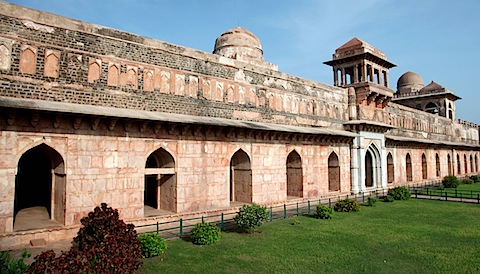


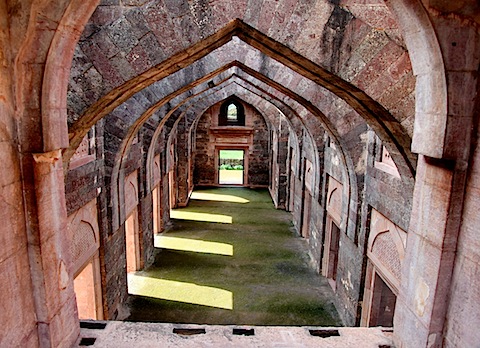
The sense of romance is increased by the water features installed by previous sultans. One built a series of pleasure pools for his harem and many of the palaces are built right onto overgrown water tanks:


In addition to be the most romantic place in India, it also has some of the cutest kids who are all precocious enough to insist that they have their photo taken:


These kids are also learning English, although in a manner that occasionally confuses English with Hindi. In Hindi, namaste is a greeting used both upon arrival and departure. As a result, many of these kids confusingly say "bye-bye" when they meet you for the first time.
3.
The story of India is one of the world's great epics, full of some of history's most colourful characters. One of the more interesting footnotes in this story took place in Daulatabad where Mohammed Tughlaq created his capital in 1328 and marched the entire population of Delhi 1,100 km to populate it. Despite meaning "City of Fortune", it turned out to be anything but. It left the north undefended and after a few years he marched everyone back.
Today, the fort is in ruins and over 5km of run down walls surround it while macaques are its only inhabitants.
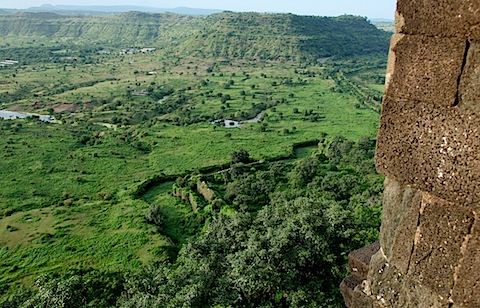
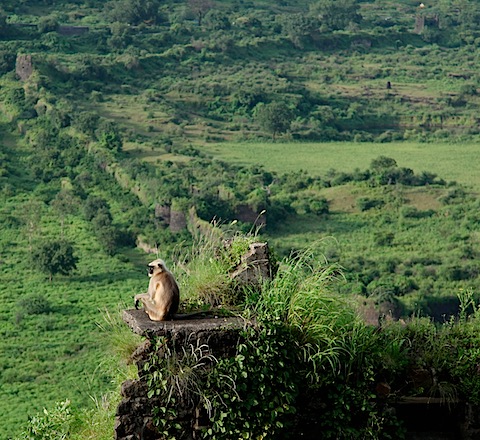
The main doors have spikes on them to prevent elephant attacks.

It's a 45 minute walk to the citadel at the top and to get there you need to go through a series of fortifications. Gates with doglegs, a moat that needs to be crossed and the unique andheri. This is literally a 'dark passage': it's an unlit corridor full of twist and turns, dead ends, steps of different sizes and numerous bats. Back in the day, defenders could pour boiling oil down the passageway or direct invaders around a corner where they would suddenly tumble to their death in a hidden pit.
Bring a flashlight.
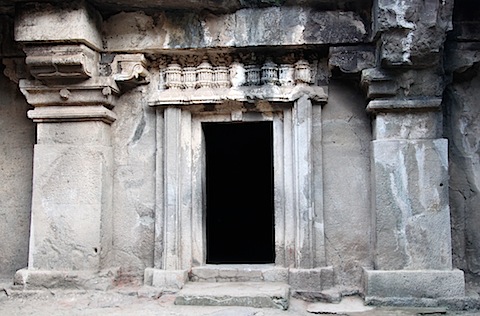
4.
When I lived in Calgary, Wen and I went out to Head Smashed In Buffalo Jump to see Western Canada's glorious UNESCO World Heritage Site. Natives dressed as wolves used to lure bison to their death by cunningly running them over a cliff. The beasts had bad eyesight and by the time the rear of a herd realized what was going on, they had already pushed the front of the herd over the cliff.
I was anticipating a huge 500 foot cliff with a pile of bleached bones at the bottom; the reality was a lot more banal: a slight grassy escarpment.

When your human history consists of primarily nomadic societies, your cultural relics are few and far between.
Nothing could be more different with India's World Heritage monuments. In Ellora, the ur-Indians spent about 500 years carving one of their escarpments into a series of over 30 competing Jain, Buddhist and Hindu caves.

Giant buddhas have been hewn out of rock:

Life-size elephants stand guard at a Jain cave...

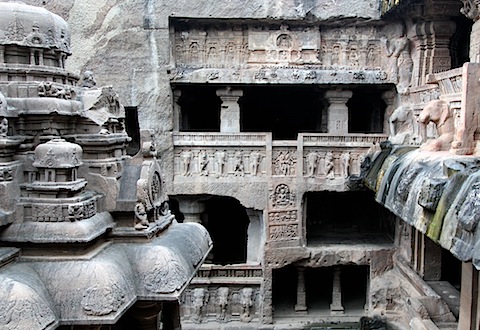
...while the Hindus went wild and spent up to 150 years carving the ultimate cave in a tribute to Shiva and his mountain abode of Mt. Kailasa:
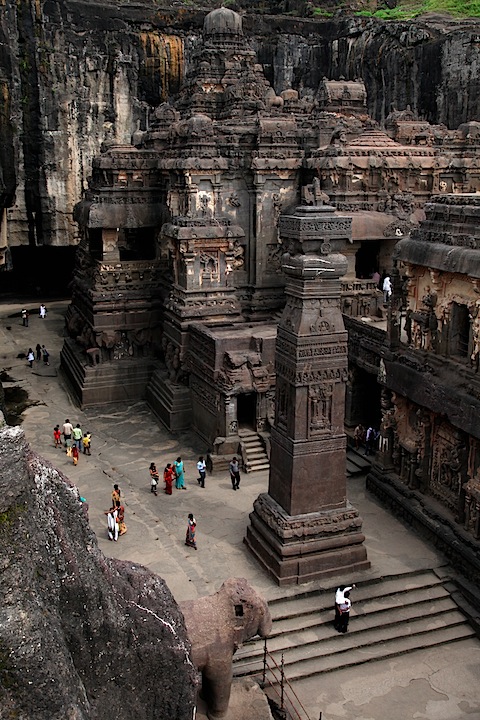

The entire cave used to be plastered and painted. And, yes, those are parrots on the right; as if that wasn't enough, there are also monkeys.

What is mind-blowing about all of these, is that they are carved from a single face of rock, from the top down. You have to keep pinching yourself to remind yourself of what an undertaking this must have been.
Oh yeah, and as it that wasn't enough, there's another site nearby (Ajanta) where there are another 30 buddhist caves that date back to 200 BC or so. Besides massive buddhas and stupas, they also include several paintings that are still intact over 1500 years later (and well lit; all these photos were taken without a flash):
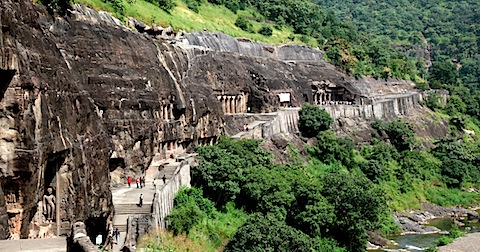
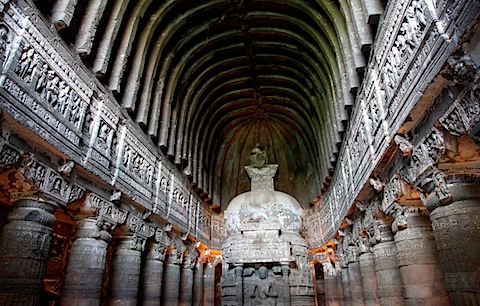
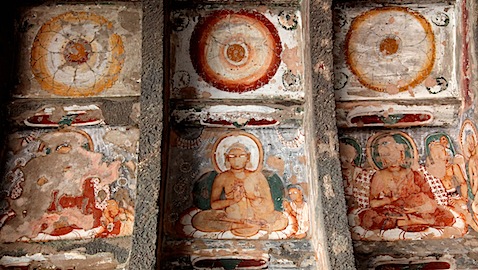
Again, all carved from the top on down...
5.
As with elsewhere in India, the food here has been delicious. I have a new favourite dish in vegetable kofta (ironically, 'kofta' means spiced meatball). The photo below comes from Prashant in Aurangabad; the kofta is in the upper left:
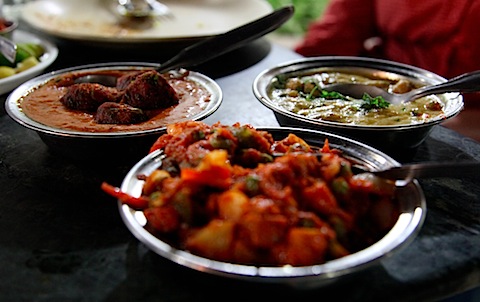
If you go to Mandu, be sure to try the kofta at Shivani (which shouldn't be hard, as it's one of three restaurants in the town).
6.
We're slowly learning different Hindi words. One of the most versatile words in ghat. It has three meanings and in one day you can actually experience all of them. A ghat can be a chain of mountains as well as the road you take through that mountain. And then, at your destination, you may find a temple with stairs that lead into a river. Yup, those stairs are also known as ghats.
7.
For some reason, cheesy songs keep following us around Southeast Asia and India. We are being stalked by The Carpenters' "Every little shalala" and Craig David's "Seven Days". I don't know what I've done to deserve this but please Buddha/Krishna/Adinth, make it stop!